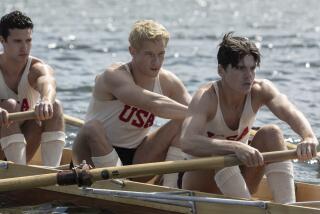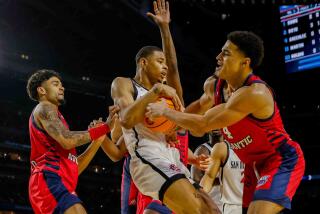Rowing for Respect at SDSU : Lightweight Crew Has Something to Prove at Nationals
- Share via
SAN DIEGO — The members of San Diego State’s lightweight crew sure picked the wrong sport in which to gain some recognition.
It’s not that these guys don’t want the recognition. They do. In fact, they crave it.
It’s just that crew is not foremost on the minds of San Diego’s sports fans. And the fact that these guys are “only” lightweights doesn’t help, either.
Crew is similar to boxing in that heavyweights get most of the attention. The heavyweights are the big guys. The average weight of the eight rowers in a lightweight boat can be no more than 155 pounds. Average weights over that figure are considered heavyweights. Although the size of the boats are the same, the lightweights are looked upon almost as the junior varsity.
The only time during the year that rowing in San Diego gets much attention is when the Crew Classic comes to Mission Bay each April.
Naturally, the main event of the Crew Classic, the Copley Cup, is for heavyweights. The lightweight race is called . . . the lightweight race.
“We are fighting for recognition all the time,” said Gary Schneider, the No. 3 man (he sits third from the coxswain) in the SDSU lightweight boat.
But recognition is not easy to come by. After all, not many people ever see these guys. They do most of their work in the early morning--like 5 a.m. Even on race days, the best courses allow a fan to see only about 200 meters of a 2,000-meter race.
“It’s true that rowing really isn’t a spectator sport,” said Scott Petry, whose dark prescription glasses make him easy to spot in the No. 1 seat. “We’re trying all the time to make a name for ourselves.”
They’re actually doing a pretty good job of that--in rowing circles, that is. The SDSU lightweights won the Pacific Coast championships on May 10 in Sacramento and are one of the favorites in the National Championships, which begin Friday in Cincinnati.
San Diego State is expected to challenge lightweight crews from Yale and Princeton, among others, in this weekend’s championships. Yale beat the Aztecs by a boat length to win at the Crew Classic two months ago.
“It will take a perfect race for us to win,” SDSU Coach Chuck Dotte said, “and it seems like we have to win. We have a sport that is just beginning to get some attention, but to get more you have to win. People, in general, don’t remember who came in second.”
Over the last couple of seasons, the Aztecs have not finished second very often. They have been the finest lightweights on the West Coast, winning the Pacific Coast championships in 1985 as well, and have gained a reputation as one of the strongest lightweight teams in the country.
“People come to San Diego State to row in the lightweight boat,” said Brian Hughes, the No. 7 man. “It’s been a tradition over the years for the lightweight boats to be good at San Diego State. When you get in one of the boats, you want to keep the tradition going.”
The tradition can go only so far, however. Hughes, for instance, had not heard much about crew when he came to San Diego State.
Hughes was a member of one of the university’s cycling clubs when the team captain told him that he looked like he would be good at crew.
“He told me to go out,” Hughes said. “I liked it and I stayed with it.”
Tom Hartley was just minding his own business walking around campus one day when he first heard about the sport.
“The coach was out there on campus recruiting and he just approached me,” Hartley said. “He said they were looking for tall people who were athletic.”
So Hartley joined. He, along with Del Hayes, is the only returner from last year’s Pacific Coast championship boat.
“A lot of times, when people do recognize us, they do by saying how crazy we must all be,” Hartley said. “People have this conception of us getting up at the crack of dawn every day and going down to the water to work like hell.”
Is their conception right?
“Yeah, I guess it is,” Hartley said. “But I don’t mind it.”
The conception that more of the rowers would like understood is that they do work hard. Sure, they say, they don’t do it for anyone but themselves, but they feel the hard work does deserve some respect at least.
The rowers on SDSU’s heavyweight boat respect them. And they should.
“We beat them all the time,” said John Lingham, a junior on the lightweight boat.
Maybe not all the time.
According to Dotte’s recollection: “I’d say the lightweights win 60% of the time. It’s not as unusual as one might think. We have a very strong lightweight program here.”
The question, then, is why aren’t the heavyweights as good?
“At this school, all of the best and biggest athletes go out for the bigger sports,” Dotte said. “We have no scholarships here for any rowers. At the big rowing schools (like Washington) where the heavyweights are good, they have so much money.”
Being in the heavyweight boat at SDSU can get frustrating. Petry, in fact, used to be a heavyweight before switching to the lightweight boat.
“It’s a whole different world,” Petry said. “Now, I feel like I’m a big fish in a smaller pond instead of the other way around.”
Nonetheless, the heavyweights are making their mark, too.
Bruce Branstine is a part of the heavyweight four (four heavyweight rowers) boat that also is going to Cincinnati to compete. There is no National Championship for the heavy fours, just as there was none for the lightweights until this year.
“Still, this gives us a great opportunity,” Branstine said of the exhibition races for the heavy fours. “We don’t have the depth to compete with the other schools in the heavyweight eight races, but with four we can do better.”
A victory by the heavy fours, of course, would lend even more respect to San Diego State rowing nationwide. And if that happens, these rowers can go to work on getting some more attention in San Diego.
More to Read
Get our high school sports newsletter
Prep Rally is devoted to the SoCal high school sports experience, bringing you scores, stories and a behind-the-scenes look at what makes prep sports so popular.
You may occasionally receive promotional content from the Los Angeles Times.






